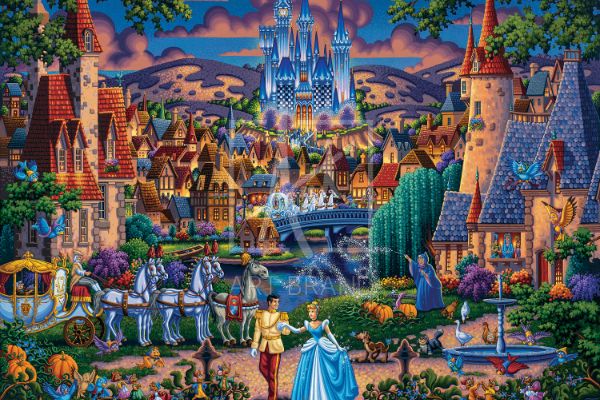
The tale of Cinderella has transcended time and culture, becoming a universal symbol of hope, transformation, and enchantment. It’s not just a story but a visual spectacle, capturing the hearts of many, including artists like Thomas Kinkade.
This article discusses how Cinderella continues to inspire visual storytelling, especially in the works of Thomas Kinkade and his studios, and how it has become an iconic theme in art and decor.
Historical Perspective On Cinderella In Art
From its early origins, Cinderella’s journey from rags to royalty story has captivated the art world. Through centuries it’s stood as a profound narrative of transformation and resilience. This tale, rooted in folklore, has been depicted in various forms and styles, each reflecting the social and cultural ethos of its time.
Early Art Highlights Themes Of Endurance
In earlier art periods, the story often took on a more somber tone, highlighting the struggles and hardships Cinderella endured. These early artworks were less about enchantment and more about the stark realities of life, embodying themes of suffering, endurance, and the stark class distinctions prevalent in those times. Paintings and sculptures from these periods often portrayed Cinderella in moments of solitude or sorrow, emphasizing the weight of her servitude and the harshness of her life before the magical intervention.
The Renaissance Represents A Shift To The Transformative
As time progressed, the narrative of Cinderella in art began to evolve, mirroring the changing perspectives of society. By the time of the Renaissance and onward, artists started to focus more on the transformative and romantic aspects of the story.
This shift is most evident in the depiction of key moments like the intervention of the fairy godmother, the magical transformation, and the royal ball. The fairy godmother’s role became a symbol of hope and miraculous change, leading to artworks that were imbued with a sense of wonder and optimism.
Modern Depictions Focus On Romance & The Triumph Of Good
The Cinderella story in this era became a canvas for artists to explore themes of destiny, romance, and the triumph of good over adversity. The portrayal of the royal ball, in particular, became a popular scene, capturing the essence of Cinderella’s dramatic change in fortune.
This era’s art highlights the romantic scene where Cinderella and Prince Charming meet, like the sweet Romance Awakens, often bathed in soft, ethereal light, symbolizing the dreamlike quality of the moment. The clock striking midnight also became a significant element, representing the fleeting nature of this magical transformation but also the enduring hope it instilled as depicted in Clock Strikes Midnight.
Psychological & Cultural Impact
Cinderella’s story is more than a fairy tale. It’s a narrative that speaks to the human spirit’s resilience. This universal appeal is why artists continue to revisit her story. The tale’s psychological depth and cultural significance make it a compelling subject for artists seeking to explore themes of hope, transformation, and romance.
Cinderella In Modern Art
In the modern era, Disney’s portrayal of Cinderella has had a significant influence on how the story is depicted in art. The brilliantly lit Cinderella Dancing in the Starlight, where Cinderella and Prince Charming dance, has become an iconic scene. The dramatic moment when the Fairy Godmother saves Cinderella and transforms her for the ball, like in Wishes Granted, has also become widely recognized. These elements of visual storytelling resonate deeply with artists and audiences alike.
The Thomas Kinkade Connection
Thomas Kinkade, often referred to as “Thom,” had a unique approach to painting fairy tales, including Cinderella. His works are known for their magical quality, where light seems to dance and twinkle as in Cinderella Wishes Upon a Dream, echoing the royal fanfare and romantic scenes of the Cinderella story. Thomas Kinkade Studios continues this legacy, creating Cinderella concept paintings that capture the essence of the tale in a way that is both nostalgic and fresh.
Concept Paintings Tell Multiple Stories In One Piece
Each brushstroke and color choice contributes to the nuanced storytelling, inviting interpretation and contemplation. Concept paintings have the unique ability to convey a multitude of storylines, allowing artists to explore diverse themes or layers of meaning within a unified canvas. As in the striking Cinderella’s Enchanted Evening, where the whole night of magic is depicted in one artwork, or Disney Cinderella Happily Ever After, in which Cinderella not only marries, but a whole journey is implied.
Cinderella’s Influence On Other Art Forms
The influence of Cinderella extends beyond paintings and illustrations. Sculptures, films, and theatrical productions also draw inspiration from her story, showcasing its versatility as a source of creative inspiration.
Visit The Thomas Kinkade Galleries In Carmel, Monterey & Placerville For Cinderella-Themed Art
The enduring legacy of Cinderella in visual arts is a testament to the tale’s universal appeal. Artists like Thomas Kinkade have immortalized her story in vividly colorful paintings, contributing to its status as a beloved theme in Disney art, decor, and wall art. From Cinderella’s Castle to various Cinderella paintings, the story continues to captivate and inspire, reminding us of the power of hope and transformation.
Visit our Carmel, Monterey, and Placerville, CA galleries to pick up a Cinderella painting for your home.
